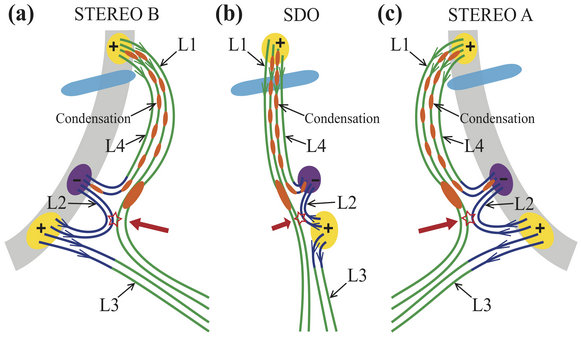A new formation mechanism for solar coronal rain
Rain is a common phenomenon on the Earth, especially in the summer. It plays an important role in the water cycle. In the same way, there is a similar phenomenon on the Sun, called coronal rain (see Figure 1). It is a most fascinating feature due to its link to the coronal heating and magnetic field, and plays a fundamental role in the mass cycle between the hot, tenuous corona and cool, dense chromosphere.
Coronal rain usually takes place in the post-flare loops and the non-flaring active region coronal loops. It is classified generally into two categories: flare-driven and quiescent coronal rain, depending on its relation with the flare. Both kinds of coronal rain form along structures that are magnetically closed.
Recently, a research team led by Dr. LI Leping from National Astronomical Observatories of Chinese Academy of Sciences (NAOC) found a new type of coronal rain forming along open magnetic structures, away from the magnetically closed region, and proposed a new formation mechanism for coronal rain along open magnetic structures facilitated by interchange magnetic reconnection between open and closed magnetic structures.
A series of studies were issued since 2018, among which the latest paper was published in The Astrophysical Journal on April 1, 2021.
In this formation mechanism (see Figure 2), the higher-lying open structures reconnect with the lower-lying closed loops, forming a magnetic dip in the former. The plasma, surrounding the dip, converges into the dip, resulting in the enhancement of plasma density in the dip. The density enhancement triggers thermal instability. Cooling and condensations of hot coronal plasma in the dip thus occur. The cool condensations fall down toward the solar surface as coronal rain.
No flare was detected during the reconnection and condensation process. The new type of coronal rain hence belongs to the quiescent coronal rain. "The quiescent coronal rain forming along the open structures is quite different from the flare-driven coronal rain in post-flare loops and the quiescent coronal rain in non-flaring active region loops that occur in the closed loops," said Dr. LI Leping, the first author of the series of studies.
All the reconnection and condensation events investigated before took place above the limb. "Whether the condensation facilitated by reconnection can still be observed on the disk, and how it performs, are open questions," said Prof. Hardi Peter from Max-Planck Institute for Solar System Research (MPS), a co-author of the series of studies.
The researchers chose a time period when the viewing angle of SDO is mostly perpendicular to those of STEREO A and B. During this time period, the reconnection condensation events, observed above the eastern (western) limb of STEREO A (B), occurred on the disk of SDO (see Figure 2).
"The event presented is important for understanding the global picture of condensation formation in the solar atmosphere and the combined observations bring a very interesting means to analyze this type of coronal condensation events," the reviewer of the paper commented.
Above the limb, the bright condensations, and the subsequent coronal rain, facilitated by reconnection between open and closed structures were clearly detected. However, on the disk, the reconnection structures were difficult to observe. Moreover, dark condensations appeared and moved to the surface as on-disk coronal rain.
"If only the on-disk observations are available, the relation between the condensations and reconnection, shown clearly by the off-limb observations, could not be identified," said Dr. LI. "We propose that some on-disk condensation events seen in the transition region and chromospheric lines could be facilitated by interchange reconnection."

Figure 1: Flare-driven coronal rain observed by AIA on board the SDO. (Credit: NASA/SDO/Goddard Scientific Visualization Studio)

Figure 2: Schematic diagrams of the coronal condensations facilitated by interchange magnetic reconnection between open and closed magnetic structures observed from three vantage points. (Image by LI Leping)
The paper can be accessed at https://iopscience.iop.org/article/10.3847/1538-4357/abe537
Media Contact: Prof. XU Ang, annxu@nao.cas.cn